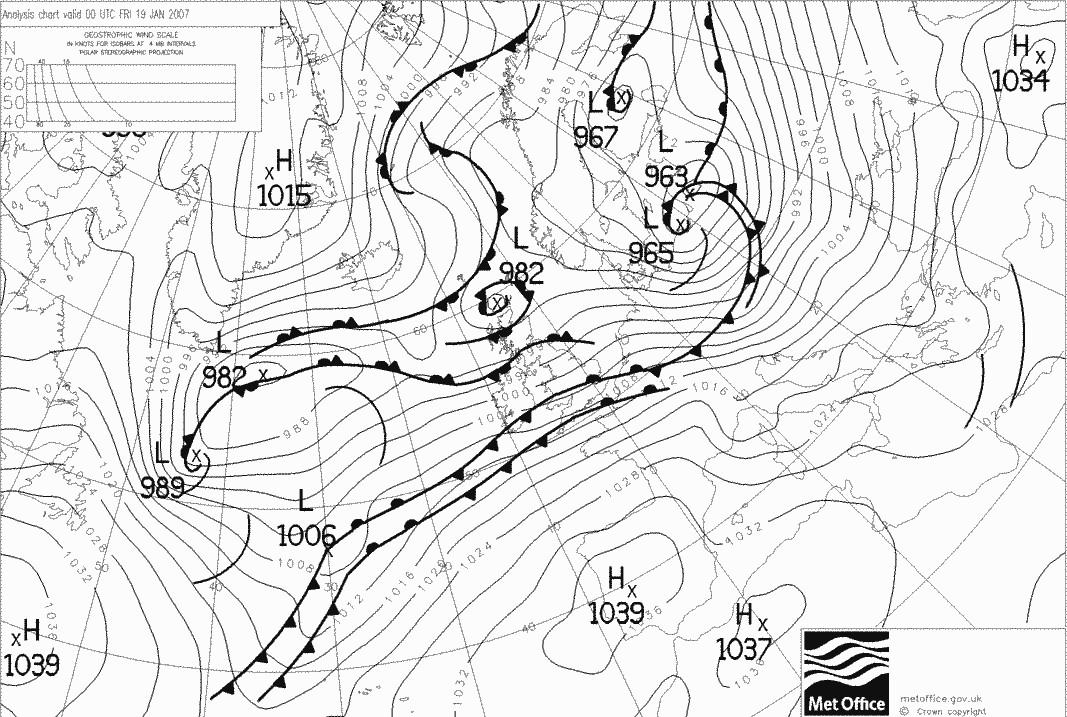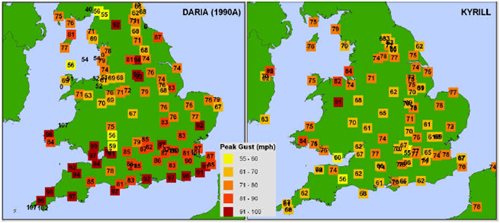|
|
|||
| |
|||
|
|
|||
Windstorm Kyrill
A relatively recent example of a powerful extratropical cyclone was windstorm Kyrill, which left a large trail of damage in its wake on January 18th 2007. The UK, northern France, the Netherlands, Germany, Austria, Poland and the Czech Republic all reported substantial damage, with 45 deaths resulting from the storm.
Storm formation and track
Associated damage and insured losses
The origins of Kyrill crossed the east coast of North America at midday on January 16th, and, propelled by an exceptionally fast jet stream, reached the UK in just two days. As the system moved into the Atlantic it developed rapidly, with subsequent interactions with the jet stream resulting in a second low forming ahead of the initial low pressure system, which would go onto to become windstorm Kyrill.
Coupled with developing high pressure areas over southern Europe (see Figure 1), Kyrill enabled the formation large pressure gradients, which led to the high windspeeds measured across Europe. Unlike most systems, as Kyrill passed over the UK it deepened briefly, sustaining damaging winds as it moved into mainland Europe .
 Figure 1: Click on image to open in a new window
Figure 1: Click on image to open in a new window
Figure
1 shows an analysis chart at 0000GMT on 19th January 2007. Areas of
high pressure over southern Europe, coupled with the low pressure
system led to damaging winds over much of Northern Europe.
Kyrill was not an
unusual windstorm in the sense of high windspeeds; however, it was somewhat
unusual in that damaging windspeeds persisted for more than 24 hours. This was partly as
a result of the reintensification as Kyrill crossed the
 Figure 2: Click on image to open in a new window
Figure 2: Click on image to open in a new window
Some of the highest windspeeds in the UK since 1990
were recorded as Kyrill struck on January 18th, with gusts up to 80mph
causing structural damage to buildings, downing trees and power lines,
and significant disruption to transport systems. Nine people lost their
lives, while several hundred thousand homes were left without power,
and railway lines were closed and flights from major airports
cancelled. A British container ship grounded in the English Channel,
with her crew airlifted to safety as she leaked 200,000 tonnes of oil,
while containers washed ashore. Estimates for insured loss for the UK are in the region of €600m (ABI, 2007).
Germany saw gust windspeeds of up to 125mph in certain parts (Benfield, 2007), as Kyrill, the strongest extratropical cyclone to hit Germany since Lothar in 1999, passed over the country. Eleven people perished and over a million homes were left without power as winds caused widespread property damage. Storm surge coupled with heavy rain led to some coastal areas being flooded.
Wind damage and lowland
flooding were also experienced in parts the Netherlands, France,
Austria, Belgium, Denmark, Switzerland, Luxembourg, and the Czech
Republic. Swiss Re report European-wide insured losses in the region of €3-3.5bn, with
the German insurance association, GDV, stating approximately €1.5bn of
insured loss was suffered by Germany alone.
References
ABI (2007). ABI Statistics. www.abi.org.uk. Last accessed
 This
page was last updated on
20th October 2009. Every effort is made to ensure links from this page
are still active; however, if you find they are not please let me know.
This
page was last updated on
20th October 2009. Every effort is made to ensure links from this page
are still active; however, if you find they are not please let me know.

